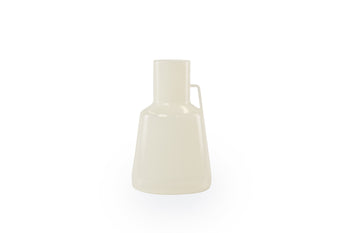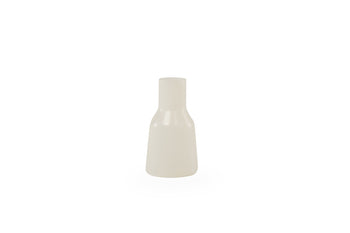
High-Performance TUNAIR™ Polypropylene Erlenmeyer Flask Systems
The TUNAIR™ polypropylene Erlenmeyer flask systems are an innovative and patented solution, meticulously designed for microbiology and biotechnology applications. These advanced flasks and closure systems combine efficiency and durability, making them an ideal choice for laboratory professionals seeking reliable tools for their experiments.
Key Features of the TUNAIR™ Polypropylene Erlenmeyer Flask Systems
The TUNAIR™ system includes a No-Baffle Shake Flask with a standard throw, comparable to a conventional Erlenmeyer flask. With a working volume of 100 ml, this system is perfect for a wide range of microbiology and biotechnology applications.
Each package comes complete with the following:
- Twelve (12) polypropylene 300 ml No-Baffle TUNAIR™ Shake Flasks.
- Twelve (12) two-piece caps constructed from durable polypropylene.
- Fifteen (15) Dri-Gauze filters designed for efficient filtration.
Advanced Dri-Gauze Filters
The Dri-Gauze filters included in this system are constructed of nitrocellulose and feature a 0.22-micron pore size, ensuring effective filtration. Each filter is reusable and can withstand 10 to 12 uses, providing excellent value and efficiency. These filters are fully autoclavable, allowing them to remain in the cap assembly until a replacement is necessary.
When it’s time to replace the filters, the process is straightforward and user-friendly. The filters can be autoclaved directly within the cap assembly, minimizing handling and maintaining sterility.
Durable Two-Piece Cap Assemblies
The two-piece cap assemblies are expertly crafted from polypropylene, making them resistant to most solvents. These caps are designed to provide a secure fit and are fully autoclavable for repeated use. The assembly's innovative design ensures ease of replacement and maintenance, promoting longevity and usability in demanding laboratory environments.
To replace the filter lining in the cap assembly:
- Pinch the flanges of the inner-closure shell until they snap loose.
- Pull apart the cap and remove the used lining.
- Replace the lining by positioning it between the two parts of the cap.
- Snap the cap back together, ensuring the flanges of the inner piece lock into the mated grooves of the outer piece.
This reassembly method ensures the cap stays secure during rigorous use, preserving the integrity of your experiments.
Easy Cleaning and Maintenance
TUNAIR™ Erlenmeyer flasks and caps are designed for easy cleaning and maintenance. To clean:
- Soak the flasks and caps in water with a mild detergent solution to loosen dirt and contaminants.
- Rinse thoroughly with clean water.
- Allow the components to air dry completely before reuse.
This straightforward cleaning process ensures your TUNAIR™ system remains free of contaminants, ready for your next experiment.
Why Choose TUNAIR™ Erlenmeyer Flask Systems?
TUNAIR™ polypropylene Erlenmeyer flask systems stand out in the market due to their combination of durability, versatility, and innovative design. The No-Baffle Shake Flasks offer a working volume of 100 ml, providing flexibility for various applications. The inclusion of high-quality, reusable Dri-Gauze filters and solvent-resistant cap assemblies ensures long-term performance and cost-efficiency.
With their user-friendly maintenance and replacement processes, TUNAIR™ flasks and caps are engineered to simplify laboratory workflows, allowing researchers to focus on their work without worrying about equipment reliability.
Applications of the TUNAIR™ Erlenmeyer Flask Systems
These flasks are ideal for a wide range of applications, including:
- Microbial culture growth.
- Biotechnological experiments requiring optimal aeration.
- Filtration and containment of biological samples in controlled environments.
Whether used in academic research, industrial biotechnology, or clinical laboratories, TUNAIR™ Erlenmeyer flask systems are a trusted choice for professionals who demand consistent and reproducible results.
Order Today
The TUNAIR™ polypropylene Erlenmeyer flask systems are a versatile and high-performance solution for modern laboratories. From their durable, autoclavable components to the innovative design of their Dri-Gauze filters and cap assemblies, these flasks offer unparalleled reliability and convenience. Optimized for microbiology and biotechnology applications, TUNAIR™ Erlenmeyer flask systems are an essential tool for achieving precise and efficient laboratory results.
Invest in the TUNAIR™ system today to experience the difference in quality and performance for yourself. Perfect for researchers and professionals who value practicality and durability, these flasks will elevate your laboratory workflows and ensure success in every experiment.
- Specifications
- Technical Information
Flask Dimensions:
Flask Size: 300 ml
Working Volume: 100 ml
Base Diameter: 3.25” [8.25 cm]
Neck Diameter: 1.75” [4.45 cm]
Height: 6.00” [15.24 cm]
Weight: 0.01 lbs. [0.004 Kg]
Mixing:
No-Baffle (0 Baffles): Normal Throws
Shaker Speed:
1” Throws: 300-400 rpm or possibly higher
2” Throws: 150-200 rpm or possibly higher
Material:
All TUNAIR flasks and caps are constructed of chemical resistant polypropylene. All flasks and caps are fully autoclavable.
300 ml flask:
Allows for approx. 150 ml (max) of working volume for culturing cells
2.5 Liter flask:
Allows for approx. 1 liter (max) of working volume for culturing cells
No-Baffle:
The bottom inside of the flask is smooth and flat. This configuration will generate a single vortex within the media inside the flask when fastened to an orbital shaker. The shaker will need to operate at speeds above 160 rpm in order to form that vortex in the media.
Two Piece Cap:
The 300 ml flask and 2.5 L flask both have a special cap and filter system that promotes gas exchange and maintains sterility of the growth culture during use. The inner portion of the cap unsnaps from the outer portion by pushing in the tabs on the side of the cap assembly and then pulling the insert out.
0.2-micron filters:
There are two different types of 0.2-micron filters available for the TUNAIR flasks. These filters allow for maximum gas exchange while maintaining sterility.
Dri-Gauze – This is a paper filter than can be used approx. 6 to 8 times before having to be replaced. This filter can be autoclaved while in the cap, on the flask, for 6 to 8 times.
Silicone – This is a silicone filter that will last the life of the flask. This filter can be autoclaved while in the cap and on the flask for many times.
Cap & Filter assembly:
Once you have the 2-piece cap assembly apart (either the 300 ml cap or the 2.5 L cap) place the corresponding filter size inside the cap and the re-assemble the inner and outer cap pieces making certain to align the tabs with their associated holes. Once clipped into place, make certain the filter completely covers the cap assembly openings.
Attaching the flasks to your shaker:
IBI TUNAIR flasks can be used with nearly all standard shakers and shaker clamps. The 2.5-liter flask typically fits best into the 2-liter shaker clamp. The 300 ml flask typically fits best in the 250 ml shaker clamp.
Preparing and Cleaning the TUNAIR flask:
Your TUNAIR flasks are constructed of polypropylene plastic which allows them to be autoclaved. Once you have prepared your media inside the flask you can place the cap & filter on the flask and insert into the autoclave. Set the autoclave for wet cycle.
Once you have harvested your cells, wash the TUNAIR flask in a mild dish soap such as Dove Dish Soap then rinse well with DI water. Do NOT rinse the Dri-Gauze filter between uses. The silicone filter can also be rinsed with DI water if needed. Observe the condition of the filters between runs to make certain there are no holes or tears in the filter. If there are, replace the filter immediately.
Cell Growth Evaluation of Commonly Used Shake Flasks:
TUNAIR™ flasks were compared to conventional flasks using four different types of microorganisms; Escherichia coli, Saccharomyces cerevisiae, Penicillium avellaneum, and Streptomyces chartreusis. The aeration capacities of the shake flasks were determined by the sulfate oxidation method, and the values shown below are presented as oxygen absorption rate (OAR) in mM oxygen/L/Min. The growth rates of E.coli and S.cerevisiae were expressed as optical densities (OD) at 555 mM. For S.chartreusis and P.avellaneum growth rates were evaluated by percent sedimentation. For E.coli and S.cerevisiae, the growth rates were determined after an 18-hour incubation period; for S.charteusis, a 24-hour incubation period; and for P.avellaneum, a 72-hour incubation period. Growth and OAR evaluations were carried out with 3-9 replicates and statistically analyzed using Turkey’s w-procedure. See results below.
Growth Chart:
| OAR Value | OD @ 555 mM | % Sedimentation | |||
|---|---|---|---|---|---|
| Flask | mM O2/L/Min. | E.coli | S.cerevisiae | S.chartreusis | P.aveilaneum |
| TUNAIR™ Full-Baffle | 4.25 | 7.09 | 5.63 | 19.7 | 3.3 M |
| TUNAIR™ Half-Baffle | 1.22 | 5.36 | 5.57 | 27.73 | 30.50 P |
| Triple Indented Flasks | 2.47 | 5.97 | 5.31 | 19.20 | 9.50 MP |
| Unbaffled Erlenmeyer | 0.52 | 5.97 | 5.19 | 17.37 | 25.10 P |
Growth Morphology:
M, mycelial; P, pellet; MP, mixed mycelial. The mycelial growths mostly adhered to the walls of the flask, which accounted for the low overall sedimentation value.
Growth Comparison of Saccharomyces Cerevisiae in TUNAIR™ Shake Flasks and Brand C Shake Flasks:
The experiment was done on a New Brunswick INNOVA 44 shaker incubator.
It was conducted at different speeds – 200 rpm & 300 rpm.
Strain: Saccharomyces Cerevisiae
Medium: YPD broth (Yeast Extract Peptone Dextrose)
Flasks: IBI TUNAIR™ 300 ml Flask and Brand C 250 ml Growth Flasks
Cell Analyzer: Vi-Cell XR
Growth chart: S.Cerevisiae Growth Chart
Experiment Summary:
In this experiment, standard volume--60 & 50 ml YPD--was used for TUNAIR™ and Brand C flasks, which is 20% capacity of the flasks. The flasks were incubated at 30°C at speeds of 200 rpm and 300 rpm for 28 hours. After taking viable cell counts, it was found that under low speed (200 rpm) both TUNAIR™ and Brand C flasks contained yeast cultures of higher cell densities when compared to the higher speed (300 rpm) cell culture flasks. It was also noted that the TUNAIR™ flask had higher cell density at 200 rpm and 300 rpm when compared to the Brand C flask. Although these data indicate TUNAIR™ flasks support higher density cell growth, we expected that higher speed (rpm) should produce higher cell density due to the higher dissolved oxygen concentration and better dispersion of cells. This unexpected data might be due to frozen cell culture stock, which might take a longer time to adapt to the environment.More experiments are required and are being carried out at this time. The focus of these experiments will involve:
• Varying shaker speeds and varying volumes of medium in the TUNAIR™ and Brand C flasks
• Comparative studies between TUNAIR™ 2.5-L growth flasks and Brand C 2-L flasks
• Varying shaker speeds and varying volumes of medium in the larger TUNAIR (2.5 L) and larger Brand C (2 L) flasks
Reference Papers:
1. Method to Increase the Yield of Eukaryotic Membrane Protein Expression inSaccharomyces Cerevisiae
2. Optimisation of Recombinant Production of Active Human Cardiac SERCA2a ATPase












